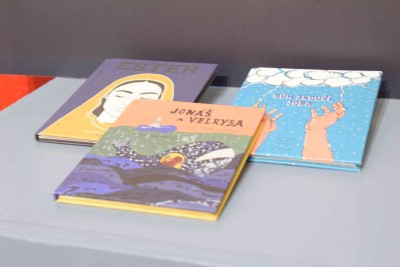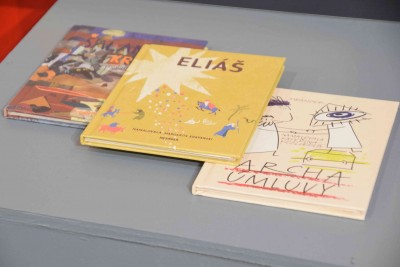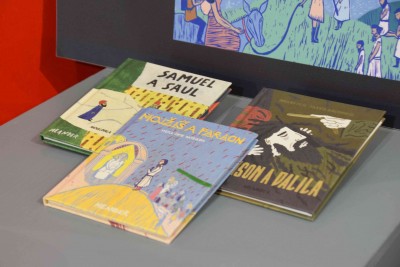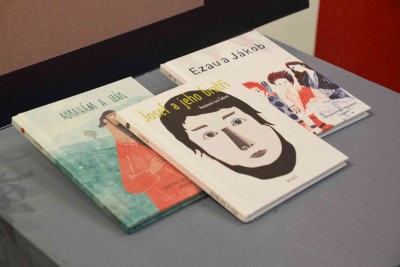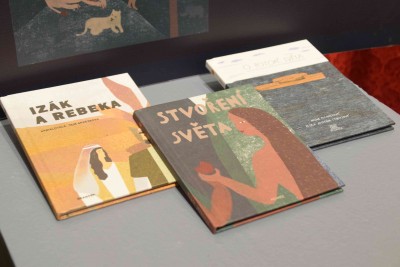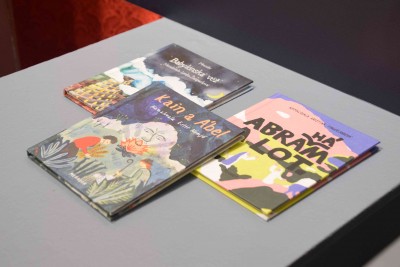THE MANAMANA EDITION
22 tales of the Old Testament illustrated by young visual artists
All biblical texts adapted by Ivana Pechácková. The illustrations come from carefully chosen fresh graduates of Czech fine art schools. Published by the prominent Czech children’s literature publishing house Meander, MANAMANA presents the best of contemporary book illustration.
| 1 The Creation illustration by Monika Novotná 2 Cain and Abel illustration by Ester Nemjó 3 The Flood illustration by Petra Josefína Stibitzová 4 The Tower of Babel illustration by Lenka Žampachová 5/I Abram and Lot illustration by Kristina Fingerland 5/II Abraham and Isaac illustration by Jakub Kouril | 6/I Isaac and Rebekah illustration by Taja Spasskova 6/II Esau and Jacob illustration by Saki Matsumoto 7 Joseph and His Brothers illustration by Lucie Šatková 8 Moses and the Pharaoh illustration by Žofie Matejková 9 The Red Sea Crossing illustration by Nikola Logosová 10 The Ten Commandments illustration by Marie Štumpfová 11 The Ark of the Covenant illustration by Katerina Kozlíková 12 Samson and Delilah illustration by Jakub Bachorík 13 Samuel and Saul illustration by Anna Kulíková 14 David and Goliath illustration by Nikola Horení | 15 Solomon the King illustration by Laura Hédervári 16 Elijah illustration by Margarita Khavanski 17 Daniel in the Lion’s Den illustration by Štepánka Jislová 18 Jonah and the Whale illustration by Alžbeta Zemanová 19 Esther illustration by Anna Niklová 20 God Tests Job illustration by Marcela Konárková |
The Taste of Mana
However omnipresent in the previous centuries, biblical topics may today seem rather distant to many, be it because of memories of the most boring Sunday school lessons or the currently prevailing atheism. There is a tendency to move away from the traditions and change their meaning. We can hardly change the deep roots of culture and its archetypes though. Talking about the European tradition, it is good to see that even the facts and principles of today’s modern, digital world stem from a certain foundation. It is good to know the most popular stories - even if, according to a legendary sketch from a mock debate H?m?ní (Thundering) by Czech satiric theatre group Sklep, Bible is “a lengthy and literarily unbalanced publication composed of two inadequate parts: The Old Part, where the hero never comes, and The New Part, which is dedicated exclusively to him”.
Perhaps that is why it takes courage and great imagination to illustrate the stories of both Old and New Testament. There are no instructions on how to draw God, the Flood or fratricide for kids. The attempts to illustrate Bible can be traced back to the Middle Ages and biblia pauperum. The Bible of the Poor told the biblicalstories in images and was designed to help illiterate believers understand.
Following the history of Bible visual adaptation, we find out that almost all visual art from the Middle Ages to baroque period is based on an iconographic reading of biblical texts. Thus, the history of art itself is in large measure a reading from the Scripture. Try to imagine The Tower of Babel. Very probably, you will automatically see it through Pieter Brueghel’s eyes. A similar thing will happen with Paradise and the mad visions of Hieronymus Bosch. Bible became material suitable for illustration also for many other significant artists: Rembrandt, Marc Chagall, Gustav Doré, and in a very intimate version, Bohuslav Reynek.
The name of the edition MANAMANA refers to both the divine meal and the catchy tune sang by Sesame Street’s Muppets. The edition strives to modernize one of the oldest books - one which in its primal form has no ambition to appeal to children. Ivana Pechácková adapted the content for the smallest readers in a simplified, yet not rash way, shortening the stories but preserving the legacy at their cores. Each of the 20 books of the series is illustrated by another author, each time a young visual artist. You can find a number of children’s bibles on the market. Mostly they are illustrated in a cheesy realistic style though, leaving no space for reading in between the lines.
MANAMANA freshens the conservative religious vision with a breath of plurality. Thus, God acts in the form of a metaphorical hand in one story while being a blazing eye and white-haired old man in others. The space is given to children’s imagination and the fact that you can only see God the way you do.
Emma Hanzlíková
Gallery


.jpg)
.jpg)
.jpg)
.jpg)
.jpg)
.jpg)
.jpg)
.jpg)
.jpg)
.jpg)
.jpg)
.jpg)
.jpg)
.jpg)
.jpg)
.jpg)
.jpg)
.jpg)
.jpg)
.jpg)
.jpg)
.jpg)
.jpg)
.jpg)
